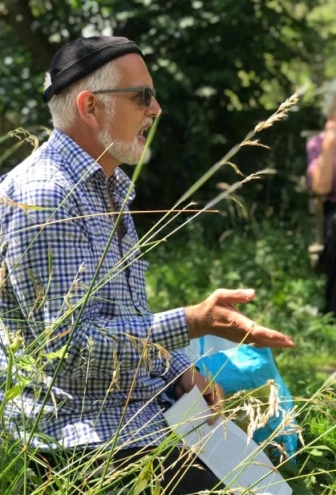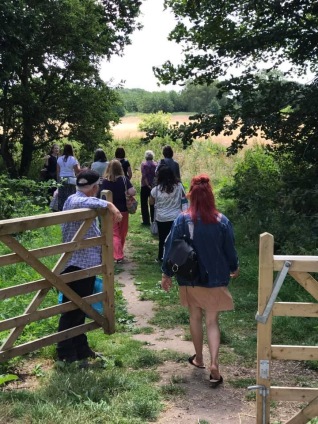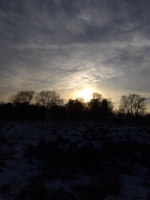I love being outside, and from camping and hiking with the Woodcraft Folk on, I’ve loved storytelling outside too. I love warm summer days teaching, and this time earlier in July with Home Start was a joy in so many ways (I mentioned them in the previous two posts).  Anna from Home Start has been kind enough to let me reuse the pictures she took, and I’m vain enough to have picked this photo. “You’ve got your gob open,” was the immediate family comment. Yes, I have: it is at once in the same tradition and a long way from all those MSS of the medieval Magister spouting in a lecture. I was reminded sharply while I was working with their volunteers of the story in Kevin Crossley-Holland and Jill Paton Walsh’s Wordhoard in which the new teacher in the monastery school lets the boys out to read and learn in the orchard.
Anna from Home Start has been kind enough to let me reuse the pictures she took, and I’m vain enough to have picked this photo. “You’ve got your gob open,” was the immediate family comment. Yes, I have: it is at once in the same tradition and a long way from all those MSS of the medieval Magister spouting in a lecture. I was reminded sharply while I was working with their volunteers of the story in Kevin Crossley-Holland and Jill Paton Walsh’s Wordhoard in which the new teacher in the monastery school lets the boys out to read and learn in the orchard.
The perspicacious will also note that I’m not reading a story at this point, but discussing an article, down by my side – specifically Wyver et al (2010) The Ways to Restrict Children’s Freedom to Play: the problem of surplus safety, Contemporary Issues in Early Childhood Vol 11, no 3 – to explain something about safety and families. I love exploring that article; it is such a judicious mix of research synthesis and plain common sense. But of course I did it with a story and it’s that pedagogic tool I first want to reflect on.
Teaching isn’t stand-up, I know, but there is always some room for a story in teaching, whether it’s through sharing a book (Anthony Browne this time; maybe Up The Mountain next time?), or a traditional tale told orally (next time I meet Home Start will be the autumn: I think hallowe’en pumpkins may get a look-in), or an anecdote to illustrate a point. This episode in our morning’s training was about giving parents permission – if such a thing is needed – to do a little bit of thinking ahead and then to let the children explore. The group picked up on the phrase surplus safety. It’s not without risk, and the story I told was of a boy who fell while out of Forest School whose dad said to me “He never has an accident with me; he’s always in his pushchair.” The spin I put on it was that children need to be given opportunities. As Shirley Wyver and team point out:
They [sc children] will make postural adjustments to maximise stability and efficiency….
and they suggest that early protection from falling can limit the problem-solving a child needs to do on unfamiliar terrain. We discussed the section in Wyver’s article where she suggests it’s a mistake to think small children are not good walkers: children need to exercise (and so, often, do we). And walking brings us away from the adult as in charge, the story-teller/performer.
S tory is not all that happens outside. The very experience itself affords the chance to chat, to wander, to find a new way or a new place – and this is the problem with story as outdoor pedagogy: it is still too close to the teacher-as-Master. Again, this was something we discussed, and I confessed how hard I find it not to jump in and explain: this is called n…; that x is brilliant because it smells like… While there is clearly a place for “the naming of parts,” for the acquisition of agreed names, there must also be time for independent discovery, for the friend who brings you an egg-shell they have found, for the ladybird on the hand, the sound of the wind in the grass, or even, simply – as one of the people I was with pointed out – that not all grass in green. Warneford Meadow lived up to my praise of it: the grasses were purple and tawny-gold.
tory is not all that happens outside. The very experience itself affords the chance to chat, to wander, to find a new way or a new place – and this is the problem with story as outdoor pedagogy: it is still too close to the teacher-as-Master. Again, this was something we discussed, and I confessed how hard I find it not to jump in and explain: this is called n…; that x is brilliant because it smells like… While there is clearly a place for “the naming of parts,” for the acquisition of agreed names, there must also be time for independent discovery, for the friend who brings you an egg-shell they have found, for the ladybird on the hand, the sound of the wind in the grass, or even, simply – as one of the people I was with pointed out – that not all grass in green. Warneford Meadow lived up to my praise of it: the grasses were purple and tawny-gold.
 the wild wood as evening closes in. More modern writers have given us some great examples of snowy landscapes and confronting death: Philip Pullman works the theme extremely well in
the wild wood as evening closes in. More modern writers have given us some great examples of snowy landscapes and confronting death: Philip Pullman works the theme extremely well in 



